Specifying Units Of Interest¶
This chapter describes the means available to convey the set of units on which coverage should be assessed, which we commonly refer to as the units of interest, and which are relevant to gnatcov instrument, gnatcov run and gnatcov coverage.
There are two main families of such means: users would either provide the set
of files which hold the coverage obligations for the units of interest, or
rely on project files facilities to designate the set of units. At analysis
time, the actual list of unit names for which a report or checkpoint is
produced as well as the list of individually ignored source files for each unit
can be displayed with the --dump-units-to option of the
gnatcov coverage command.
Providing coverage obligation files (--scos|--sid)¶
With the --scos or --sid command line arguments, users
convey the set of units of interest by directly providing the set of files
which contain the coverage obligations for those units.
The --scos switch is for binary trace based analysis and the files
to provide are the Library Information files produced by the compiler
(.ali files for Ada, .gli files for C). The --sid switch is
for source trace based analysis and the files to provide are the .sid
Source Instrumentation Data files produced by gnatcov instrument. In
all cases, the files are located at the same place as where the object file
for a unit is produced.
The following paragraphs provide details and examples on the use of
--scos with .gli or .ali files. The same principles apply
to --sid with .sid files.
Each occurrence of --scos on the command line expects a single
argument which specifies a set of units of interest. Multiple occurrences are
allowed and the sets accumulate. The argument might be either the name of a
single Library Information file for a unit, or a @listfile argument
expected to contain a list of such file names.
For example, focusing on Ada units u1, u2 and u3 can be achieved
with either --scos=u1.ali --scos=u2.ali --scos=u3.ali, with
--scos=u3.ali --scos=@lst12 where lst12 is a text file containing the
first two ALI file names, or with other combinations alike.
The GNAT toolchain provides a useful device for list computations: the
-A command line argument to gnatbind which produces a
list of all the .ali files involved in an executable construction. By
default, the list goes to standard output. It may be directed to a file on
request with -A=, and users may of course filter this
list as they see fit depending on their analysis purposes.
Below is an example sequence of commands to illustrate, using the standard
Unix grep tool to filter out test harness units, assuming a basic naming
convention:
# Build executable and produce the corresponding list of ALI files. Pass
# -A to gnatbind through gprbuild -bargs then filter out the test units:
gprbuild -p --target=powerpc-elf --RTS=zfp-prep -Pmy.gpr
test_divmod0.adb -fdump-scos -g -fpreserve-control-flow -bargs -A=all.alis
# Run and analyse all units except the test harness:
grep -v 'test_[^/]*.ali' all.alis > divmod0.alis
gnatcov run --level=stmt+mcdc --scos=@divmod0.alis
gnatcov coverage --level=stmt+mcdc --annotate=xcov --scos=@divmod0.alis
Using project files (-P, --projects, --units)¶
As an alternative to providing the complete list of coverage obligation files
with --scos or --sid, you can use project files to specify
units of interest. When both obligation files and project file options are on
the command line, the former prevail and the project files are only used for
switches or the determination of the target and runtime configuration.
The units of interest designation with project files incurs two levels of selection: first, specify the set of projects of interest where the units of interest reside, then specify units of interest therein.
Conveying projects of interest¶
The set of projects of interest is computed by the following rules:
A set of base projects is first selected from the recursive dependency closure of a root project;
A set of candidate projects of interest is established, as the union of the dependency closures of all the base projects by default, or as the mere set of base projects alone if the
--no-subprojectsswitch is used;The actual projects of interest are the candidate ones minus those with an
Externally_Builtattribute set to"True".
For the determination of the base projects set, a single root project
must first be specified using the -P option. The set may then be
refined according to the following rules with an optional list of
--projects switches naming projects within the dependency closure of
the root:
Without
--projects, the base projects set is the root project designated by-Palone, or the project designated by theOrigin_Projectattribute therein if there is such an attribute;With
--projectsoptions, the listed projects are taken as the base and the root project needs to be listed as well to be included.
We will illustrate the effect of various combinations, assuming an example project tree depicted below:
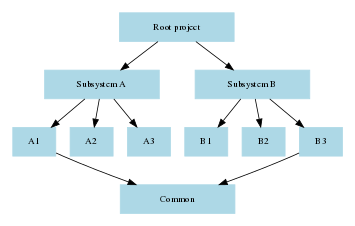
Assuming none of the projects is flagged Externally_Built:
-Proot --no-subprojects restricts the analysis to units in the root project only;
-Proot --projects=subsystem_a --no-subprojects focuses on Subsystem A alone;
If the root project is also of interest, it must be listed explicitly, as in -Proot --projects=root --projects=ss_a --no-subprojects;
Removing
--no-subprojectsas in -Proot --projects=subsystem_a, lets you consider all the projects transitively imported by the base ones;
Externally_Built attributes don’t influence the processing of dependency
closures and only prune individual projects from the final selection. In the
last example above, if project A1 had the attribute set to "True",
Common would remain of interest to the assessment even though it was
dragged as a dependency of A1.
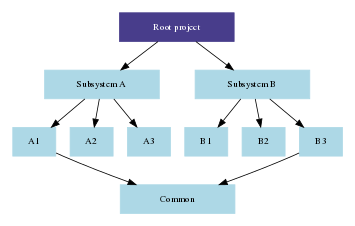
-Proot --no-subprojects¶
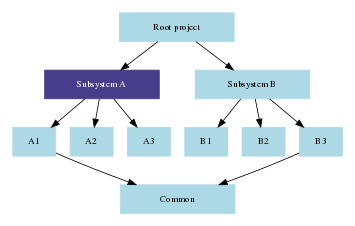
-Proot --projects=subsystem_a --no-subprojects¶
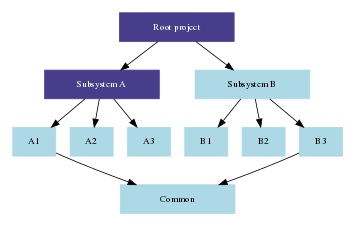
-Proot --projects=root --projects=ss_a --no-subprojects¶
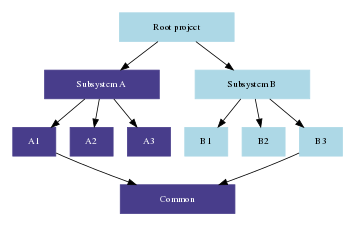
-Proot --projects=subsystem_a¶
Conveying Units of interest within projects¶
By default, all the units encompassed by a project of interest are considered
of interest. This can be tailored first with specific attributes in package
Coverage of project files.
Four attributes are available to control the set of units to be considered of
interest within a project: Units, Units_List, Excluded_Units, and
Excluded_Units_List.
Units and Units_List are used to construct an initial set of units for
which coverage analysis should be performed. For example, given a project
with three packages Pak1, Pak2, and Pak3, if you want to do
coverage analysis only for Pak1 and Pak3 you can specify:
package Coverage is
for Units use ("pak1", "pak3"); -- pak1 and pak3 are of interest
end Coverage;
Similarily to Sources and Sources_List, the Units attribute
specifies a set of units and Units_List specifies the name of a text file
containing a list of units. See the Compilation unit vs source file names section for details
how individual units should be denoted depending on the source language.
Excluded_Units and Excluded_Units_List operate like Units and
Units_List but for units that should never be considered of interest for
coverage. Back to our example, the same result as above is obtained by
specifying:
package Coverage is
for Excluded_Units use ("pak2"); -- all units except pak2 are of interest
end Coverage;
When the exclude/include sets overlap, the excluding attributes prevail over the including ones. The exact rules for computation of the units to be considered of interest within a project are as follows:
An initial set is determined using the
UnitsandUnits_Listattributes in the project’sCoveragepackage; By default, if no such attribute is found, the initial set comprises all the units of the project,Units determined using the
Excluded_UnitsandExcluded_Units_Listattributes are removed from the initial set to yield the set to consider.
Finally, the list of units of interest for a given execution of gnatcov can also
be overriden from the command line using the --units switch. When
this option is used, the project files attributes are ignored.
Each occurrence of this switch indicates one unit to focus on, or with the @ syntax the name of a file containing a list of units to focus on.
Conveying source files to ignore within units¶
Two attributes in the Coverage package make it possible to specify
specific source files to ignore, where the designated sources are part of a
unit otherwise of interest. This is intended to for situations where the
sources of a unit of interest encompass (part of) the unit testing sources
(which provides visibility on internal subprograms to the testing code).
Both attributes gather a list of globbing patterns (as in Unix shells). All source files whose name matches one pattern are excluded from the analysis and from the output report.
The first attribute, Ignored_Source_Files, expects a list of patterns:
package Coverage is
for Ignored_Source_Files use ("*-test.adb", "logger-*.adb");
end Coverage;
The second one, Ignored_Source_Files_List, corresponds to the use of
@listfile argument. In the following example, the ignore.list text
file is expected to contain a list of globbing patterns, each separated by line
breaks:
package Coverage is
for Ignored_Source_Files_List use "ignore.list";
end Coverage;
The forms above are equivalent to --ignore-source-files options on
the command line, namely
--ignore-source-files=*-test.adb --ignore-source-files=logger-*.adb for
the first example, and --ignore-source-files=@ignore.list for the second
one.
Note that the command-line arguments have precedence over the project files
attributes. In other words, as soon as the --ignore-source-files argument
is present on the command-line, both of the attributes described above are
ignored.
Other switches or attributes of importance¶
Independently from coverage considerations, project files offer a significant range of possibilities to compose a software system. To get an accurate view of the set of projects and units from which those of interest to coverage should be taken, GNATcoverage needs to operate on the same base information as the builder.
To this effect, all the switches you would pass to gprbuild to control the
build configuration should also be passed to GNATcoverage commands when conveying
units of interest through project facilities, in particular --target,
--RTS, --config switches very common in cross configurations, as well
as the -X series setting scenarii variables.
In some cases, such as --target or --RTS, the effect of the command
line switch can be achieved with a project file attribute, which GNATcoverage knows
how to interepret as well.
Compilation unit vs source file names¶
For Ada, explicit compilation unit names are given to library level packages
or suprograms, case insensitive. This is what must be used in project file
attributes or --units arguments to elaborate the set of units
of interest, not source file names.
This offers a simple and consistent naming basis to users, orthogonal to the
unit/source name mapping. Consider, for example, a project file with the set
of declarations below, which parameterizes the source file name to use for the
body of a Logger package depending on the kind of build performed:
type Build_Mode_Type is ("Production", "Debug");
Build_Mode : Build_Mode_Type := external ("BUILD_MODE", "Debug");
package Naming is
case Build_Mode is
when "Production" =>
for Implementation ("Logger") use "production-logger.adb";
when "Debug" =>
for Implementation ("Logger") use "debug-logger.adb";
end case;
end Naming;
Regardless of the build mode, restricting the analysis to the Logger
package would be achieved with -P<project> --units=logger or
with a Units attribute such as:
package Coverage is
for Units use ("Logger"); -- compilation unit name here
end Coverage;
Source file names are used in the output reports, still, either in source
location references as part of the =report outputs, or as the base
filename of annotated source files for other formats. For our Logger case
above, the analysis with, for example, --annotate=xcov of a program
built in Debug mode would yield a debug-logger.adb.xcov annotated source
result.
For C, the notion of translation unit resolves to the set of tokens that the compiler gets to work on, after the pre-processing expansion of macros, #include directives and the like. This doesn’t have an explicit name and units of interest must be designated by the toplevel source file names from which object files are produced.
Typically, from a sample foo.c source like:
#include "foo.h"
static int bar (void)
{ ... }
...
void foo (int x)
{ ... }
gcc -c foo.c -fdump-scos ... would produce a foo.o object file, a
foo.c.gli companion Library Information file, and excluding it from the
analysis scope can be achieved with:
package Coverage is
for Excluded_Units use ("foo.c"); /* source file name here */
end Coverage;